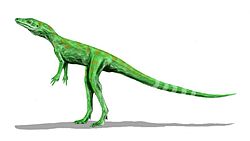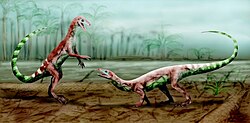Paleobiota
Color key
| Notes Uncertain or tentative taxa are in small text; |
Reptiles
Archosaurs
Other archosaur fossils include remains of an unnamed silesaurid [7] and a partial femur of a theropod or herrerasaurian dinosaur referable to the Chindesaurus + Tawa clade. [8]
| Archosaurs of the Colorado City Formation | ||||||
|---|---|---|---|---|---|---|
| Genus / Taxon | Species | Material | Location | Notes | Images | |
| "Chatterjeea" [4] | C. elegans [4] | Vertebrae, hip bones, and femora [4] |
| Postcranial bones of an unusual bipedal archosaur related to poposaurids. [4] Later determined to be synonymous with Shuvosaurus , a shuvosaurid poposauroid initially misidentified as a theropod dinosaur. [9] |  | |
| Coahomasuchus | C. kahleorum [3] | Two skeletons, one of which is nearly complete [3] while the other shows adaptations for a carnivorous diet. [10] | An aetosaurine aetosaur | |||
| Crocodylomorpha [11] | indet. [11] | Isolated ilium [11] |
| An unnamed basal crocodylomorph, one of the oldest from North America. [11] | ||
| Desmatosuchus? | D. spurensis? | Osteoderms (scutes) and vertebrae [4] | Most Otis Chalk desmatosuchin aetosaur fossils have been referred to Longosuchus or Lucasuchus, but a few have been referred to Desmatosuchus (Episcoposaurus) haplocerus. [4] The modern valid combination for this species is Desmatosuchus spurensis. [12] | |||
| Dromomeron | D. gregorii [13] | Hindlimb bones (femora and tibiae) [13] |
| A lagerpetid avemetatarsalian |  | |
| Lepidus [14] | L. praecisio [14] | Partial hindlimb (tibia, fibula, astragalus) [14] |
| A possible coelophysid theropod, potentially the oldest dinosaur from North America. [14] |  | |
| Longosuchus | L. meadei | Skulls, osteoderms, vertebrae, other postcrania [4] [10] |
| A common desmatosuchin aetosaur previously considered a species of Typothorax . |  | |
| Lucasuchus [4] | L. hunti [4] | Osteoderms and other referred fossils (including a possible skull) [4] [10] |
| A desmatosuchin aetosaur similar to Longosuchus [3] but most likely a distinct valid taxon. [15] | ||
| Poposaurus | P. gracilis | Hip and ankle bones [4] |
| A poposaurid poposauroid | ||
| P. langstoni [4] | Hip bones and vertebrae [4] |
| A poposaurid poposauroid previously given its own genus, Lythrosuchus [4] | |||
| Postosuchus | P. kirkpatricki | Vertebrae and hindlimb bones [4] |
| A rausuchid loricatan | ||
Phytosaurs
| Phytosaurs of the Colorado City Formation | ||||||
|---|---|---|---|---|---|---|
| Genus / Taxon | Species | Material | Location | Notes | Images | |
| Angistorhinus | A. alticephalus | Partial skeleton with skull [4] |
| Probable junior synonym of A. grandis. | ||
| A. grandis | Several complete skulls and associated cranial and postcranial fragments [1] [4] [16] | A common mystriosuchine phytosaur. Some sources refer all Otis Chalk Angistorhinus material to "Angistorhinus megalodon", [4] while most other sources support affinities with the type species Angistorhinus grandis from Wyoming. [16] |  | |||
| Brachysuchus | B. megalodon | Two nearly complete skulls and postcranial fragments |
| A mystriosuchine phytosaur closely related to Angistorhinus, and sometimes regarded as a species within that genus. [4] |  | |
| Paleorhinus | "P." sawini [4] | A skull [4] |
| A basal (non-mystriosuchine) phytosaur from Borden County. Probably does not form a clade with other species referred to Paleorhinus or Parasuchus. | ||
| P. bransoni | Several skulls [4] |
| A common basal (non-mystriosuchine) phytosaur, sometimes considered a species of Parasuchus . |  | ||
Other reptiles
| Other reptiles of the Colorado City Formation | ||||||
|---|---|---|---|---|---|---|
| Genus | Species | Material | Location | Notes | Images | |
| Ankylosuchus [17] | A. chinlegroupensis [17] | Partial skeleton with cranial and pelvic fragments, osteoderms, vertebrae, and an indeterminate limb bone [17] |
| A doswelliid archosauriform. | ||
| Doswellia | D. kaltenbachi | Vertebrae and osteoderms [4] |
| A doswelliid archosauriform. [4] |  | |
| Malerisaurus | M. langstoni [18] | Disarticulated skeleton [18] [19] |
| A carnivorous azendohsaurid allokotosaurian in the subfamily Malerisaurinae. Regarded as a chimera by Spielmann et al. (2006), [20] but treated as valid by other sources. [18] [19] Numerous disarticulated Malerisaurus-like fossils are also known from Quarry 1 (TMM 31025). [19] |  | |
| Otischalkia | O. elderae | Humeri, femora [4] |
| A dubious putative rhynchosaur, likely synonymous with Malerisaurus langstoni. [19] Supposed premaxilla fossils have been reinterpreted as metoposaurid cleithra. [19] Femora and humeri previously referred to this species likely belong to Trilophosaurus [4] or Malerisaurus [19] instead. | ||
| Protecovasaurus [21] | P. lucasi [21] | Teeth [21] |
| A reptile of uncertain affinities known from serrated teeth similar to ornithischian dinosaurs. [21] | ||
| Trilophosaurus | T. buettneri | Numerous skulls, braincases, and postcranial material [4] [22] | A common trilophosaurid allokotosaurian. [22] | |||
| Triopticus [23] | T. primus [23] | Partial skull [23] |
| A protopyknosian archosauriform with a reinforced skull similar to pachycephalosaurid dinosaurs. [23] | ||
Amphibians
| Amphibians of the Colorado City Formation | ||||||
|---|---|---|---|---|---|---|
| Genus | Species | Material | Location | Notes | Images | |
| Anaschisma | A. browni | Numerous skulls, interclavicles, clavicles, vertebrae, and other postcranial bones [4] |
| A common metoposaurid temnospondyl, previously named under the genus Koskinonodon or Buettneria [4] |  | |
| Latiscopus [24] | L. disjunctus [24] | A skull [24] |
| A latiscopid temnospondyl [24] | ||
Fish
Fish fossils from Quarry 1 (NMMNH 860 / TMM 31025) include lungfish teeth ( Arganodus ? [1] ), coelacanth scales, "palaeoniscid" scales (aff. Turseodus [1] ), and hybodont shark teeth and spines ( Lissodus ? [1] or Lonchidion ?). [21]
| Fish of the Colorado City Formation | ||||||
|---|---|---|---|---|---|---|
| Genus / Taxon | Species | Material | Location | Notes | Images | |
| Cionichthys | C. greeni [25] | Articulated skulls and postcrania [25] |
| A redfieldiiform actinopterygian (ray-finned fish) | ||
| Lasalichthys | L. hillsi | Skull, scale, and postcranial fragments [25] [26] | A redfieldiiform actinopterygian | |||
| L. otischalkensis [26] | Numerous articulated skulls and postcrania [26] |
| A redfieldiiform actinopterygian. [26] Some specimens were previously referred to Lasalichthys (= Synorichthys) stewarti. [26] | |||



